It looks like you're using an Ad Blocker.
Please white-list or disable AboveTopSecret.com in your ad-blocking tool.
Thank you.
Some features of ATS will be disabled while you continue to use an ad-blocker.
32
share:
Hello all.
One of the hobbies I share with my Dad is rocket-mass heaters. It's a good excuse to play with fire and mud at the same time.
Anyhow, I've read a few things in the news about the EPA dropping the hammer on wood-burners. So I wanted to do something. I've been working on this for the last month or so. You guys will have to forgive my photography. I'm just throwing this out there for anybody who is into this sort of thing.
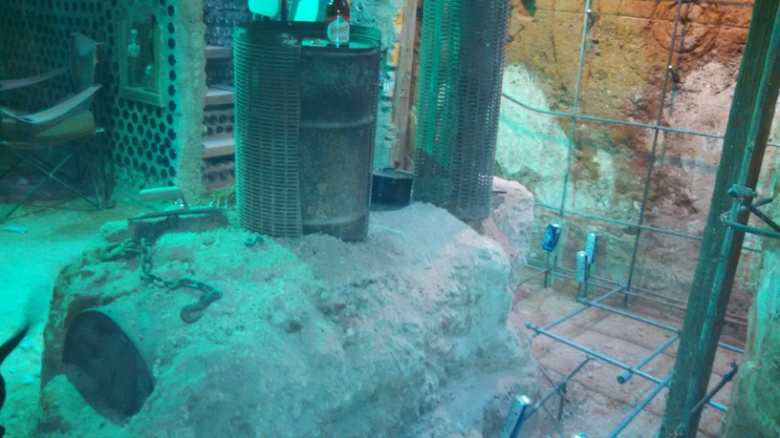
This was our second rocket-mass. It was made out of a 25 gallon drum, and a 35 gallon drum. It lasted a little over two years, but was about to burn out. We wanted to rebuild it before the core and riser dropped.
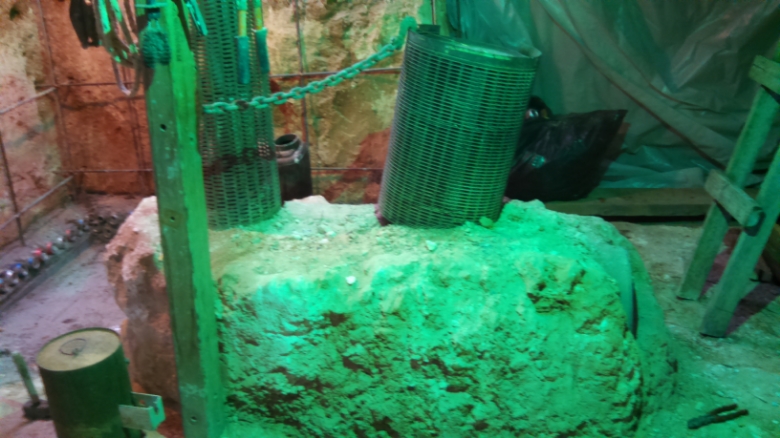
Here you can see just how badly the core and riser were leaning. It was a good heater. We carved it out of the dirt as we worked on the man-cave. It served it's purpose.
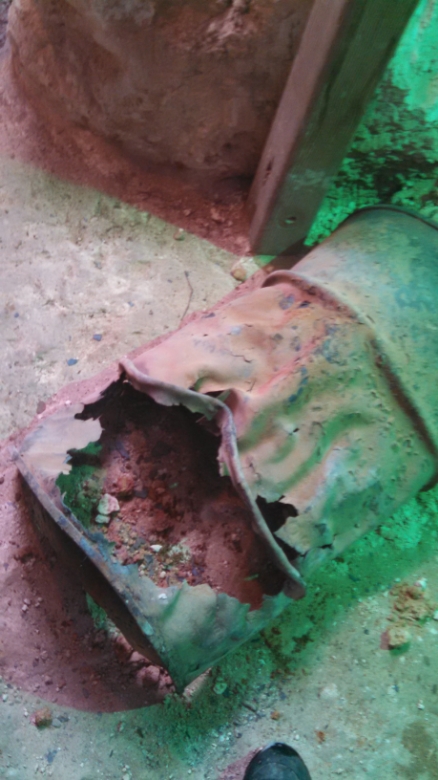
After demolition, we see just how burned out the burn-box actually is. Wow.

We left the pad, and the original exhaust box in place to keep from having to manufacture a new one. This heater is temporary as Dad and I will build a more ornate and functional version in the man-cave.
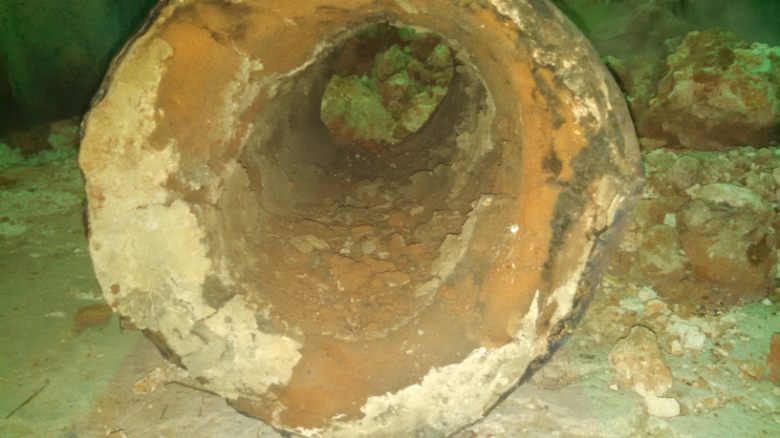
To my surprise, The original core was in pretty good shape. The internal stove pipe had incinerated, but the clay held up very well. You make a core by starting with stove pipe, then get some metal flashing and wrap it into a tube. Use bailing wire to size and secure it to about 1.5 to 2 inches larger in diameter than the stove pipe. Then fill the gap with clay and allow it to dry somewhat. I don't have pics of that process here as we reused the original core with a new stove-pipe insert.
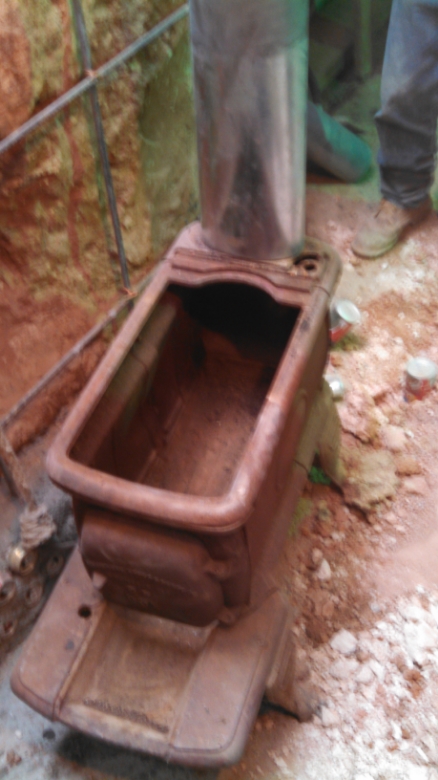
Here is where the Wood-Burner comes in. This thing has been a yard ornament for the last couple years with us. I think it was a yard ornament for a couple decades with the previous owner.
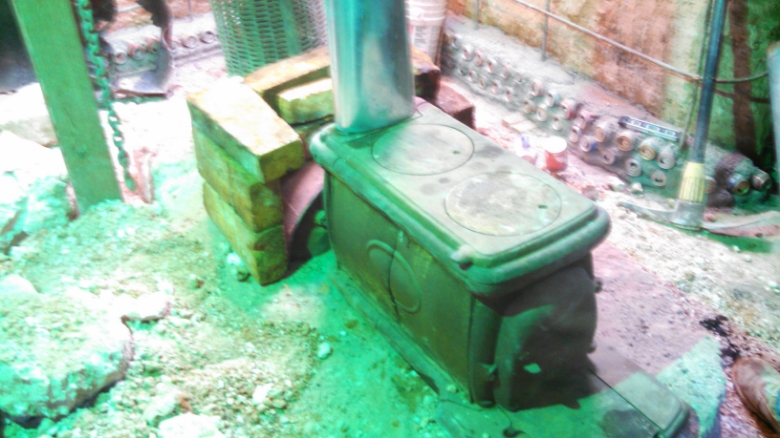
We took the legs off and set it on the pad where the previous burn-box had rested. We will use the exhaust port to be the inlet to the combustion chamber. We dry-stacked some reclaimed fire-bricks to make the transition and base for the core and riser.
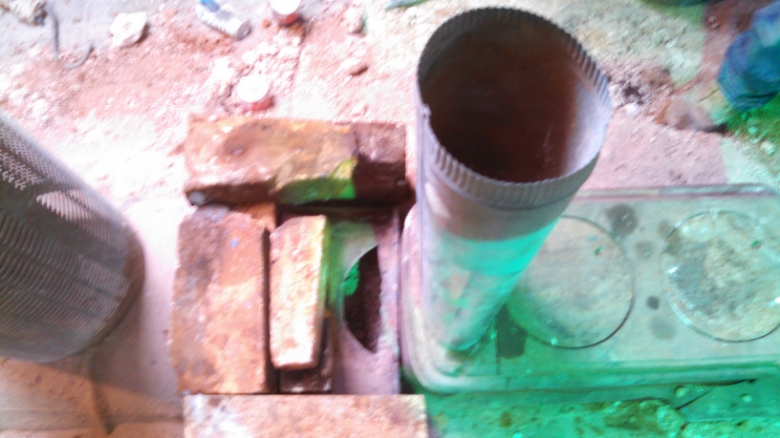
Here is a top view. You see the inlet for the exhaust box and the new stove-pipe insert for the core.

Then we mixed a batch of cob. Just clay, sand. straw and water. Make it to a workable consistency. If it gets runny, add more material.
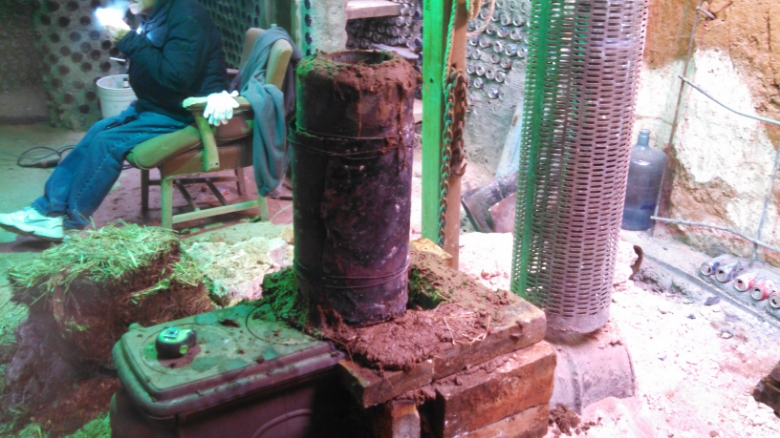
Now for the fun as we mud in the transition and place the core on it's new burn-box.
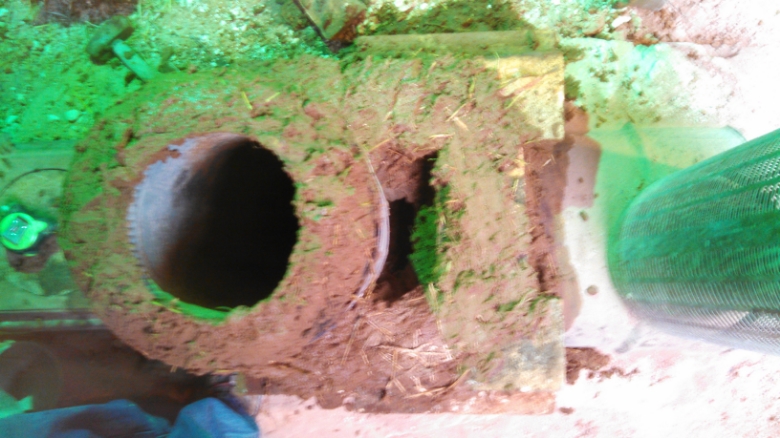
More mud fun. You want to make sure to get the mud worked into the gaps as well as you can to give a good seal.

Then we covered the core with the combustion chamber/riser and added mud around the seams to make sure it was a good seal. Then we lit a fire and started the burn-in. The transition has to be completely closed off or the burn box won't draft properly, and your man-cave will fill with smoke pretty quickly.
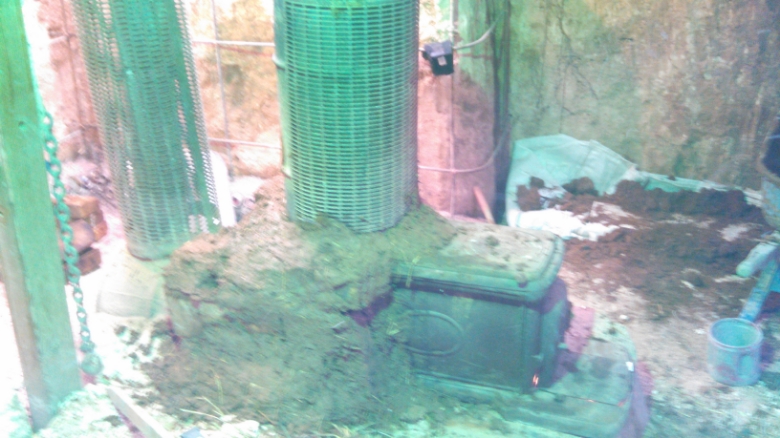
I let it burn for an hour or at this stage, and went for a snack. I wanted the mud to dry enough to start adding mass around the burn box. I used reclaimed brick for filler to speed up the process of adding mass. We will have to demo this someday and move it to its final resting place in the man-cave.
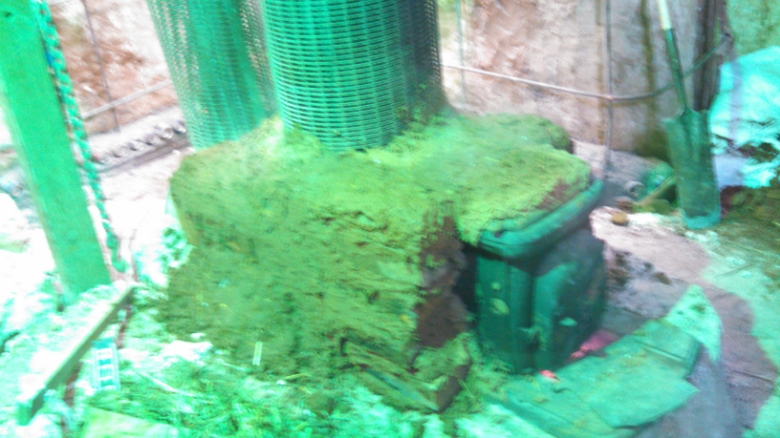
In this picture I had made more cob, stacked cob and bricks and extended the mass from the transition to the front of the burn-box. I also added a layer of cob to the top of the burn-box. Then I let that burn for an hour or so.
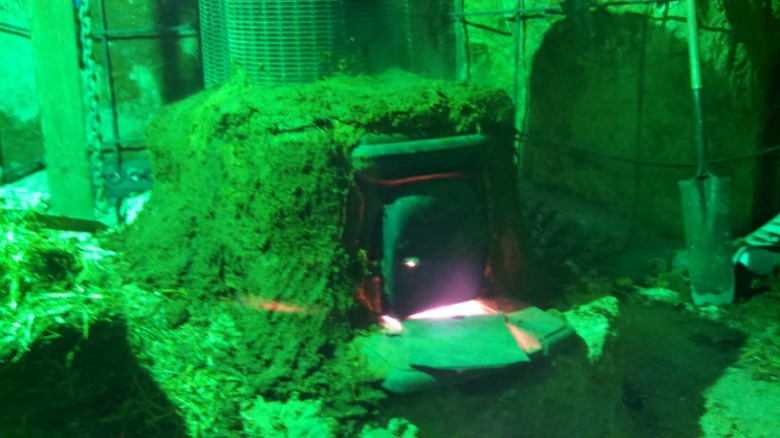
Then I cam back and stood two bricks on end and covered them with mud to bring the mass all the way to the door. Dad and I did this all over the course of a day.
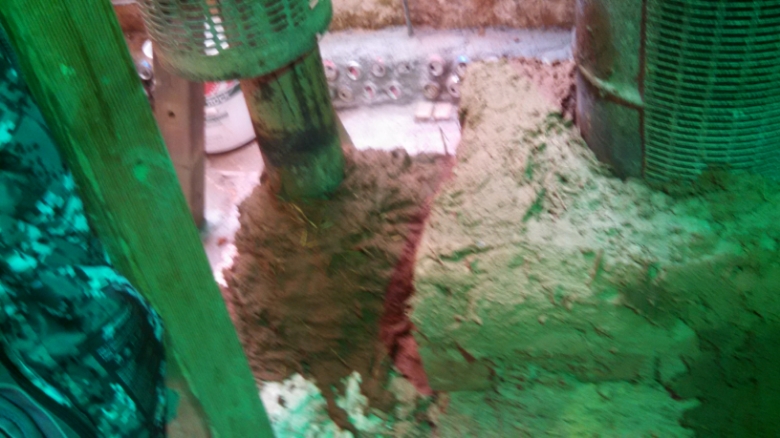
The next day we added a layer of cob to the exhaust box.

The next weekend I made a huge batch of cob and added a layer to tie the whole thing together. Thick layers crack. So I just make each finishing layer thinner and thinner to work into the imperfections and smooth everything out.
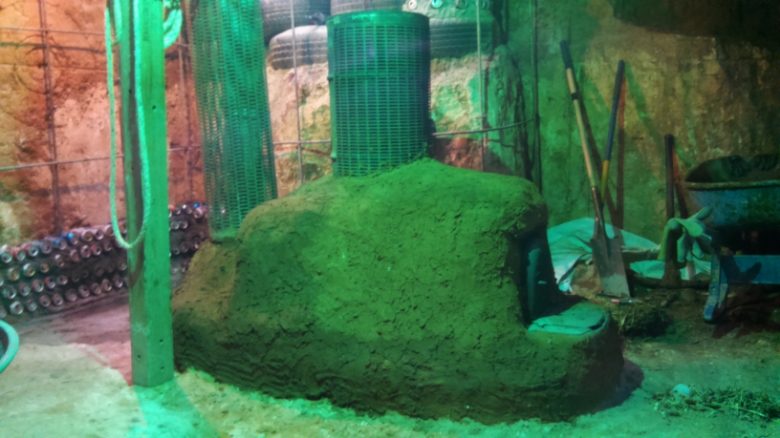
And there ya have it. It has been a fun project, but the whole man-cave is a fun project.
There are a number of you-tube videos out there that show you how to build these things. Some people are really into it and get straight scientific to reach peak efficiency and all of that. Good on them. This one probably isn't the most efficient, due to it's size and drafting characteristics. I can assure you that it is much more efficient than the wood-burner would be on it's own. With the 6-8 inches of mass around the box, we can burn a fire for about 3 hours in this thing and get about 8-10 hours of heat out of it. The riser itself probably puts off about 900 degrees or more. It does glow red. It does smoke for the first 10 or 15 minutes when you initially start a fire. Once the rocket effect starts, it emits mainly water vapor.
Hope somebody can use this information and do something for themselves.
Have fun with it, and stay warm.
Boba
One of the hobbies I share with my Dad is rocket-mass heaters. It's a good excuse to play with fire and mud at the same time.
Anyhow, I've read a few things in the news about the EPA dropping the hammer on wood-burners. So I wanted to do something. I've been working on this for the last month or so. You guys will have to forgive my photography. I'm just throwing this out there for anybody who is into this sort of thing.

This was our second rocket-mass. It was made out of a 25 gallon drum, and a 35 gallon drum. It lasted a little over two years, but was about to burn out. We wanted to rebuild it before the core and riser dropped.

Here you can see just how badly the core and riser were leaning. It was a good heater. We carved it out of the dirt as we worked on the man-cave. It served it's purpose.

After demolition, we see just how burned out the burn-box actually is. Wow.

We left the pad, and the original exhaust box in place to keep from having to manufacture a new one. This heater is temporary as Dad and I will build a more ornate and functional version in the man-cave.

To my surprise, The original core was in pretty good shape. The internal stove pipe had incinerated, but the clay held up very well. You make a core by starting with stove pipe, then get some metal flashing and wrap it into a tube. Use bailing wire to size and secure it to about 1.5 to 2 inches larger in diameter than the stove pipe. Then fill the gap with clay and allow it to dry somewhat. I don't have pics of that process here as we reused the original core with a new stove-pipe insert.

Here is where the Wood-Burner comes in. This thing has been a yard ornament for the last couple years with us. I think it was a yard ornament for a couple decades with the previous owner.

We took the legs off and set it on the pad where the previous burn-box had rested. We will use the exhaust port to be the inlet to the combustion chamber. We dry-stacked some reclaimed fire-bricks to make the transition and base for the core and riser.

Here is a top view. You see the inlet for the exhaust box and the new stove-pipe insert for the core.

Then we mixed a batch of cob. Just clay, sand. straw and water. Make it to a workable consistency. If it gets runny, add more material.

Now for the fun as we mud in the transition and place the core on it's new burn-box.

More mud fun. You want to make sure to get the mud worked into the gaps as well as you can to give a good seal.

Then we covered the core with the combustion chamber/riser and added mud around the seams to make sure it was a good seal. Then we lit a fire and started the burn-in. The transition has to be completely closed off or the burn box won't draft properly, and your man-cave will fill with smoke pretty quickly.

I let it burn for an hour or at this stage, and went for a snack. I wanted the mud to dry enough to start adding mass around the burn box. I used reclaimed brick for filler to speed up the process of adding mass. We will have to demo this someday and move it to its final resting place in the man-cave.

In this picture I had made more cob, stacked cob and bricks and extended the mass from the transition to the front of the burn-box. I also added a layer of cob to the top of the burn-box. Then I let that burn for an hour or so.

Then I cam back and stood two bricks on end and covered them with mud to bring the mass all the way to the door. Dad and I did this all over the course of a day.

The next day we added a layer of cob to the exhaust box.

The next weekend I made a huge batch of cob and added a layer to tie the whole thing together. Thick layers crack. So I just make each finishing layer thinner and thinner to work into the imperfections and smooth everything out.

And there ya have it. It has been a fun project, but the whole man-cave is a fun project.
There are a number of you-tube videos out there that show you how to build these things. Some people are really into it and get straight scientific to reach peak efficiency and all of that. Good on them. This one probably isn't the most efficient, due to it's size and drafting characteristics. I can assure you that it is much more efficient than the wood-burner would be on it's own. With the 6-8 inches of mass around the box, we can burn a fire for about 3 hours in this thing and get about 8-10 hours of heat out of it. The riser itself probably puts off about 900 degrees or more. It does glow red. It does smoke for the first 10 or 15 minutes when you initially start a fire. Once the rocket effect starts, it emits mainly water vapor.
Hope somebody can use this information and do something for themselves.
Have fun with it, and stay warm.
Boba
That looks like a real cave.
How long does it stay warm in there after the fire goes out?
How long does it stay warm in there after the fire goes out?
That's neat. I like how you used cob. It's a good building material. I bet that thing keeps you warm. I actually wouldn't mind having one. I'm
going to show my friend this.
a reply to: rickymouse
We usually build a nice fire in the morning, keep it stoked for about 3 or 4 hours. The riser stops putting off heat shortly after the fire burns out, but the mass will stay warm and radiate for anywhere from 8 to 10 hours. Still warm to the touch even 12 hours after the fire went out.
We usually build a nice fire in the morning, keep it stoked for about 3 or 4 hours. The riser stops putting off heat shortly after the fire burns out, but the mass will stay warm and radiate for anywhere from 8 to 10 hours. Still warm to the touch even 12 hours after the fire went out.
originally posted by: rickymouse
That looks like a real cave.
How long does it stay warm in there after the fire goes out?
He had said 8-10 hours of heat with 3 hours of burn. I would also like to know if that 3 hours was continuous, or spaced in the 8-10 hours.
What an amazing project. I do not think my old basement would be adequate for something like this. It seems like the body of it should be outside the house, but that certainly seems like it would require a re-design of the heat riser system.
a reply to: Skid Mark
I think every back yard/man-cave/hunting cabin should have one. I even have an over-sized disco (kind of like a big mexican wok) that I can set on the riser and make fajitas. There are many designs out there, and some of them are artistic and beautiful.
I think every back yard/man-cave/hunting cabin should have one. I even have an over-sized disco (kind of like a big mexican wok) that I can set on the riser and make fajitas. There are many designs out there, and some of them are artistic and beautiful.
a reply to: charlyv
Depending on the size of your basement, even a miniature version would adequately heat it.
These things move a considerable volume of air. In the 5 year's I've been building them I've never had a back-draft even with 60 mph winds outside. Unlike a fireplace, the smoke almost never comes back into the room. The taurus effect in the combustion chamber pulls fresh air into the burn-box to keep itself alive until there is no fuel left.
There are variations out there for almost any application.
ETA: That is a 3-4 hour continuous burn during normal operation. During the building process, I burned the heater the whole time. It was a lot of cob to dry that first day.
Depending on the size of your basement, even a miniature version would adequately heat it.
These things move a considerable volume of air. In the 5 year's I've been building them I've never had a back-draft even with 60 mph winds outside. Unlike a fireplace, the smoke almost never comes back into the room. The taurus effect in the combustion chamber pulls fresh air into the burn-box to keep itself alive until there is no fuel left.
There are variations out there for almost any application.
ETA: That is a 3-4 hour continuous burn during normal operation. During the building process, I burned the heater the whole time. It was a lot of cob to dry that first day.
edit on 1-2-2015 by Bobaganoosh because: (no reason given)
Hey OP - Thanks for the thread. Some questions...
What is your definition of a rocket-mass heater? How does it function?
What makes this a wood-burning stove/rocket-mass heater hybrid? How does one function?
What are the advantages of a wood-burning stove/rocket-mass heater hybrid?
What is the definition and function of a core and a riser? What does it mean when they "drop"?
What is an exhaust box? What is its function?
Where does the air come from for the inlet to the combustion chamber?
What is the difference between the combustion chamber and the burn box?
Sorry about all of the questions. I build spacecraft, not wood stoves and unfortunately don't have a clue about the conventions or terminology...yet!
What is your definition of a rocket-mass heater? How does it function?
What makes this a wood-burning stove/rocket-mass heater hybrid? How does one function?
What are the advantages of a wood-burning stove/rocket-mass heater hybrid?
What is the definition and function of a core and a riser? What does it mean when they "drop"?
What is an exhaust box? What is its function?
Where does the air come from for the inlet to the combustion chamber?
What is the difference between the combustion chamber and the burn box?
Sorry about all of the questions. I build spacecraft, not wood stoves and unfortunately don't have a clue about the conventions or terminology...yet!
I gotta ask about the cans along the wall.
Cause the size of that stack got bigger as the project of the heater went on.
Really cool thread tho, gotta remember this.
Cause the size of that stack got bigger as the project of the heater went on.
Really cool thread tho, gotta remember this.
a reply to: CraftBuilder
All good questions.
"What is your definition of a rocket-mass heater? How does it function?"
A rocket-mass heater is a rocket-stove with mass added to it to retain heat. It functions by manipulating the air-flow in such a way that as the fuel (wood) burns in the burn box, the smoke is then drafted to the combustion chamber where a secondary ignition takes place. It is something of a poor-mans' afterburner.
"What makes this a wood-burning stove/rocket-mass heater hybrid? How does one function?"
This is a hybrid, because instead of fabricating my burn box, I reused an old wood-burning stove. It still functions in the same fashion as originally intended, but has an afterburner to reignite the smoke and decrease particulate emission.
"What are the advantages of a wood-burning stove/rocket-mass heater hybrid?"
The advantage of adding an afterburner is to reuse the heat that escapes out the stove pipe on a conventional stove, adding the mass lets the heat radiate out for much longer than a conventional stove, and you get more bang for your buck as far as the use of your wood/fuel. It can reduce usage, as the heat is retained and radiated out in the room more slowly.
"What is the definition and function of a core and a riser? What does it mean when they "drop"?"
The core is the clay/metal cylinder that is placed where the stove pipe would be were the stove used conventionally. The riser is the 25 gallon metal drum that sits over the core. These two in combination are a combustion chamber. They were going to "drop" on the original rocket-mass heater due to the structural integrity of the original burn box being compromised by a little over two years of use.
"What is an exhaust box? What is its function?"
The exhaust box usually has an air-tight door to allow for cleaning out soot. It is a collection point for the heavier particles that doesn't ignite in the secondary combustion.
"Where does the air come from for the inlet to the combustion chamber?"
At the bottom of the door you will see a flap of metal on a pivot. I just open or close the flap to regulate the air-flow. This is a pretty old wood burner, others have more ornate breather styles.
"What is the difference between the combustion chamber and the burn box?"
The burn box is behind the door where you put the wood. The combustion chamber is the core/riser combination. There is a 2 inch gap between the top of the core and the top of the barrel or riser.
Hope that clears up some of what you were wanting to know.
All good questions.
"What is your definition of a rocket-mass heater? How does it function?"
A rocket-mass heater is a rocket-stove with mass added to it to retain heat. It functions by manipulating the air-flow in such a way that as the fuel (wood) burns in the burn box, the smoke is then drafted to the combustion chamber where a secondary ignition takes place. It is something of a poor-mans' afterburner.
"What makes this a wood-burning stove/rocket-mass heater hybrid? How does one function?"
This is a hybrid, because instead of fabricating my burn box, I reused an old wood-burning stove. It still functions in the same fashion as originally intended, but has an afterburner to reignite the smoke and decrease particulate emission.
"What are the advantages of a wood-burning stove/rocket-mass heater hybrid?"
The advantage of adding an afterburner is to reuse the heat that escapes out the stove pipe on a conventional stove, adding the mass lets the heat radiate out for much longer than a conventional stove, and you get more bang for your buck as far as the use of your wood/fuel. It can reduce usage, as the heat is retained and radiated out in the room more slowly.
"What is the definition and function of a core and a riser? What does it mean when they "drop"?"
The core is the clay/metal cylinder that is placed where the stove pipe would be were the stove used conventionally. The riser is the 25 gallon metal drum that sits over the core. These two in combination are a combustion chamber. They were going to "drop" on the original rocket-mass heater due to the structural integrity of the original burn box being compromised by a little over two years of use.
"What is an exhaust box? What is its function?"
The exhaust box usually has an air-tight door to allow for cleaning out soot. It is a collection point for the heavier particles that doesn't ignite in the secondary combustion.
"Where does the air come from for the inlet to the combustion chamber?"
At the bottom of the door you will see a flap of metal on a pivot. I just open or close the flap to regulate the air-flow. This is a pretty old wood burner, others have more ornate breather styles.
"What is the difference between the combustion chamber and the burn box?"
The burn box is behind the door where you put the wood. The combustion chamber is the core/riser combination. There is a 2 inch gap between the top of the core and the top of the barrel or riser.
Hope that clears up some of what you were wanting to know.
a reply to: Sremmos80
The cans help by reducing the amount of concrete we are using to build the man-cave. Think of it as a concrete honey-comb. It seems a little crazy, but if you find a movie on youtube called "The Garbage Warrior", it will show you all about the earth-ships of Taos, New Mexico and many alternative building concepts.
The cans help by reducing the amount of concrete we are using to build the man-cave. Think of it as a concrete honey-comb. It seems a little crazy, but if you find a movie on youtube called "The Garbage Warrior", it will show you all about the earth-ships of Taos, New Mexico and many alternative building concepts.
a reply to: Bobaganoosh
It all makes sense now, thanks! I've seen the afterburners that were basically perforated tubes that draw fresh air into the top of the burn box where it is combined with the exhaust gases which are hot enough to ignite more of the un-burnt fuel going up the chimney. The system you are using seems like it would be more efficient yet.
It all makes sense now, thanks! I've seen the afterburners that were basically perforated tubes that draw fresh air into the top of the burn box where it is combined with the exhaust gases which are hot enough to ignite more of the un-burnt fuel going up the chimney. The system you are using seems like it would be more efficient yet.
a reply to: CraftBuilder
That is correct.
From what I understand, the efficiency could be improved if I keep the same inlet as my exhaust. So, If I'm using 6" stovepipe, I would want to maintain that same size of opening throughout the entire system.
That is why I say that this hybridized version is less efficient than a true "made from scratch" rocket-mass heater. I do not maintain the 6" volume throughout the entire system. I negated that by recycling an old stove. I use the baffle to compensate, but this design requires more wood than the most efficient builds.
That is correct.
From what I understand, the efficiency could be improved if I keep the same inlet as my exhaust. So, If I'm using 6" stovepipe, I would want to maintain that same size of opening throughout the entire system.
That is why I say that this hybridized version is less efficient than a true "made from scratch" rocket-mass heater. I do not maintain the 6" volume throughout the entire system. I negated that by recycling an old stove. I use the baffle to compensate, but this design requires more wood than the most efficient builds.
a reply to: Bobaganoosh
I've been fascinated with rocket stoves and RMH's ever since I first read about them a few years ago... I'm hoping to build one in my house whenever I finally settle down somewhere - and I can convince my wife that I can make it pretty enough to her liking...
Have you considered making an Instructible to share your project with the world? I never thought about how to make a hybrid using a wood stove, and I'm sure others would like to see it as well.
A question for you, does it seem to use more wood than other rocket stoves you have built in the past? Most of the ones I see have a pretty small burn chamber and I wonder what effect the increased volume has on fuel consumption/efficiency... I suppose you could put some fire bricks into the stove to decrease the volume (while adding a little more mass) as an experiment.
Thanks for sharing!
I've been fascinated with rocket stoves and RMH's ever since I first read about them a few years ago... I'm hoping to build one in my house whenever I finally settle down somewhere - and I can convince my wife that I can make it pretty enough to her liking...
Have you considered making an Instructible to share your project with the world? I never thought about how to make a hybrid using a wood stove, and I'm sure others would like to see it as well.
A question for you, does it seem to use more wood than other rocket stoves you have built in the past? Most of the ones I see have a pretty small burn chamber and I wonder what effect the increased volume has on fuel consumption/efficiency... I suppose you could put some fire bricks into the stove to decrease the volume (while adding a little more mass) as an experiment.
Thanks for sharing!
a reply to: CommandoJoe
Yes, you are correct. This uses more wood than the super-efficient rocket-mass heater. But it would use less wood than a conventional wood stove.
I will look into the Instructibles.
Also, I have considered using fire-brick to decrease the volume. I have two obstacles to overcome in that experiment.
First, I'm out of reclaimed fire-brick, and new fire-brick is unreasonably expensive.
Second, I have to question the flow of air. I think it would be different if I had a different model stove with the baffle in the door. The air flow would be more direct.. With the way the air comes in now, I would need to use screen and have the air come from underneath, which I think would work, but moves my burn closer to the back of the stove. Or I could kind of snake the air up and over the bricks from the bottom of the door which would mean having the burn chamber closer to the top of the stove.
It would be interesting to try some things to increase efficiency.
ETA: I found a video by Paul Wheaton on a build he did. It is pretty informative. That is a pretty sweet stove that he has to work with. The air breather and square design of the box itself seems like it would be ideal to add the mass to the inside of the box.
Yes, you are correct. This uses more wood than the super-efficient rocket-mass heater. But it would use less wood than a conventional wood stove.
I will look into the Instructibles.
Also, I have considered using fire-brick to decrease the volume. I have two obstacles to overcome in that experiment.
First, I'm out of reclaimed fire-brick, and new fire-brick is unreasonably expensive.
Second, I have to question the flow of air. I think it would be different if I had a different model stove with the baffle in the door. The air flow would be more direct.. With the way the air comes in now, I would need to use screen and have the air come from underneath, which I think would work, but moves my burn closer to the back of the stove. Or I could kind of snake the air up and over the bricks from the bottom of the door which would mean having the burn chamber closer to the top of the stove.
It would be interesting to try some things to increase efficiency.
ETA: I found a video by Paul Wheaton on a build he did. It is pretty informative. That is a pretty sweet stove that he has to work with. The air breather and square design of the box itself seems like it would be ideal to add the mass to the inside of the box.
edit on 2-2-2015 by Bobaganoosh because: (no reason given)
new topics
-
BIDEN Admin Begins Planning For January 2025 Transition to a New President - Today is 4.26.2024.
2024 Elections: 1 hours ago -
Big Storms
Fragile Earth: 3 hours ago -
Where should Trump hold his next rally
2024 Elections: 6 hours ago -
Shocking Number of Voters are Open to Committing Election Fraud
US Political Madness: 6 hours ago -
Gov Kristi Noem Shot and Killed "Less Than Worthless Dog" and a 'Smelly Goat
2024 Elections: 7 hours ago -
Falkville Robot-Man
Aliens and UFOs: 7 hours ago -
James O’Keefe: I have evidence that exposes the CIA, and it’s on camera.
Whistle Blowers and Leaked Documents: 8 hours ago -
Australian PM says the quiet part out loud - "free speech is a threat to democratic dicourse"...?!
New World Order: 9 hours ago -
Ireland VS Globalists
Social Issues and Civil Unrest: 9 hours ago -
Biden "Happy To Debate Trump"
2024 Elections: 10 hours ago
top topics
-
James O’Keefe: I have evidence that exposes the CIA, and it’s on camera.
Whistle Blowers and Leaked Documents: 8 hours ago, 15 flags -
Australian PM says the quiet part out loud - "free speech is a threat to democratic dicourse"...?!
New World Order: 9 hours ago, 14 flags -
Blast from the past: ATS Review Podcast, 2006: With All Three Amigos
Member PODcasts: 12 hours ago, 13 flags -
Biden "Happy To Debate Trump"
2024 Elections: 10 hours ago, 12 flags -
Mike Pinder The Moody Blues R.I.P.
Music: 12 hours ago, 8 flags -
Shocking Number of Voters are Open to Committing Election Fraud
US Political Madness: 6 hours ago, 6 flags -
What is the white pill?
Philosophy and Metaphysics: 11 hours ago, 6 flags -
RAAF airbase in Roswell, New Mexico is on fire
Aliens and UFOs: 10 hours ago, 5 flags -
Where should Trump hold his next rally
2024 Elections: 6 hours ago, 5 flags -
Gov Kristi Noem Shot and Killed "Less Than Worthless Dog" and a 'Smelly Goat
2024 Elections: 7 hours ago, 5 flags
active topics
-
Gov Kristi Noem Shot and Killed "Less Than Worthless Dog" and a 'Smelly Goat
2024 Elections • 55 • : AwakeNotWoke -
BIDEN Admin Begins Planning For January 2025 Transition to a New President - Today is 4.26.2024.
2024 Elections • 9 • : AwakeNotWoke -
RAAF airbase in Roswell, New Mexico is on fire
Aliens and UFOs • 10 • : Ophiuchus1 -
Big Storms
Fragile Earth • 13 • : AwakeNotWoke -
SHORT STORY WRITERS CONTEST -- April 2024 -- TIME -- TIME2024
Short Stories • 26 • : Encia22 -
Biden "Happy To Debate Trump"
2024 Elections • 50 • : Lumenari -
Falkville Robot-Man
Aliens and UFOs • 9 • : CosmicFocus -
ALERT - U.S. President JOE BIDEN Examined and Found NOT OF SOUND MIND.
2024 Elections • 65 • : SchrodingersRat -
James O’Keefe: I have evidence that exposes the CIA, and it’s on camera.
Whistle Blowers and Leaked Documents • 13 • : theatreboy -
Where should Trump hold his next rally
2024 Elections • 21 • : Dandandat3
32
